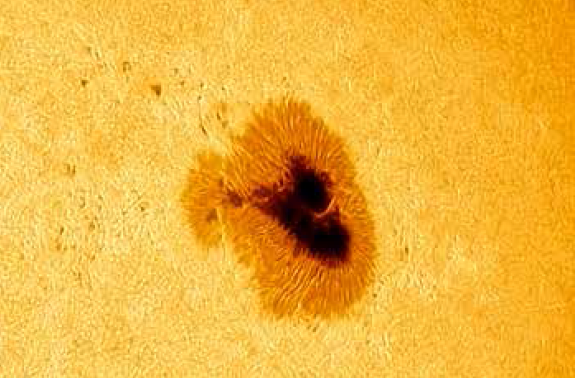On a whim, I took out my eclipseviewing glasses this past April 15 and looked at the Sun. I was contemplating starting a project on naked-eye sunspot viewing and was curious if any were visible. I hadn’t checked reports on solar activity prior to this observation, so I was pleasantly surprised to see one near the center of the disk. (It’s always more pleasing to a naked-eye sunspot than to look when a known one occurs.)
Turns out, this whopper of a spot had been around since April 7. Designated AR (active region) 2529, it had a dark umbra (inner core) that measured some 12,000 miles (19,300 kilmoeters) across, and a less dark penumbra (outer region) twice as large.
The largest sunspot of 2016 to date, AR 2529 was nevertheless a modest one historically. Take, for example, the great October 2014 naked-eye sunspot, whose penumbra spanned 80,000 miles (129,000km), wide enough to fit 10 Earths across its length; that Jupiter-sized behemoth was the biggest sunspot since November 1990.
A naked-eye study
In the 1994 Journal of the British Astronomical Association (vol. 104, p. 86), Peter Wade of Lancashire, England, details his study of naked-eye sightings from 1980 to 1994 using a welder’s glass for eye protection (#14 is the only safe grade for solar viewing). The smallest spots he detected had penumbrae with angular diameters of about 25″ (about 1.3 percent of the Sun’s diameter).
He also notes that even smaller sunspots close together could mimic a single naked-eye spot of that size. This type of “spot,” he adds, may have a diffuse appearance. He could also clearly resolve large double or multiple spots if they were separated by about 165″, although the closest two he split were only 65″ apart.
AR 2529 was a substantial sunspot, having a penumbra one near the center of the disk. (It’s always more pleasing to unexpectedly detect a nakedeye sunspot than to look when a known one occurs.) Turns out, this whopper of a spot had been around since April 7. Designated AR (active region) 2529, it had a dark umbra (inner core) that measured some 12,000 miles (19,300 kilometers) across, and of about 90″ and an umbra of about 45″ when centered on the Sun’s disk. Sunspots appear foreshortened (thinner and more elongated north to south) when near the Sun’s limb.
So, by April 17, when I last sighted the spot without optical aid, it appeared about half its size and was more difficult to detect. The dark umbra measured only about 22″ on that day. I could not separate the spot from the limb with the unaided eye on April 18, when the spot appeared half again smaller. These observations align with Wade’s experiences.
A close call
Two days after AR 2529 rotated out of view, another spot, AR 2533, rotated in. By April 26, it neared the center of the Sun’s disk with a penumbra that spanned about 26″. Try as I might, I could not detect it with confidence without optical aid; perhaps AR 2533’s umbra, only 13″ wide, contributed to its elusiveness. Nevertheless, the observation agrees well with Wade’s conclusion that the smallest spots he could detect had penumbras with diameters of 25″.
Now I’m interested in hearing from you. What is the smallest naked-eye spot you’ve seen? What were the angular extents of its umbra and penumbra? Send what you see (and don’t see) to sjomeara31@gmail.com.










